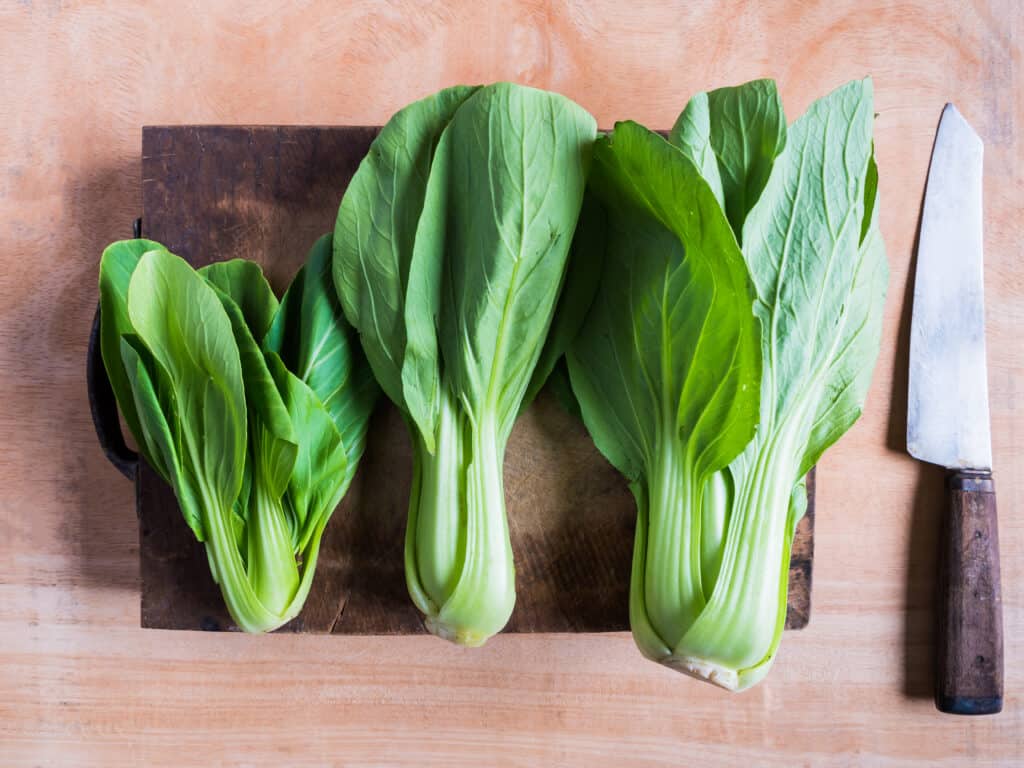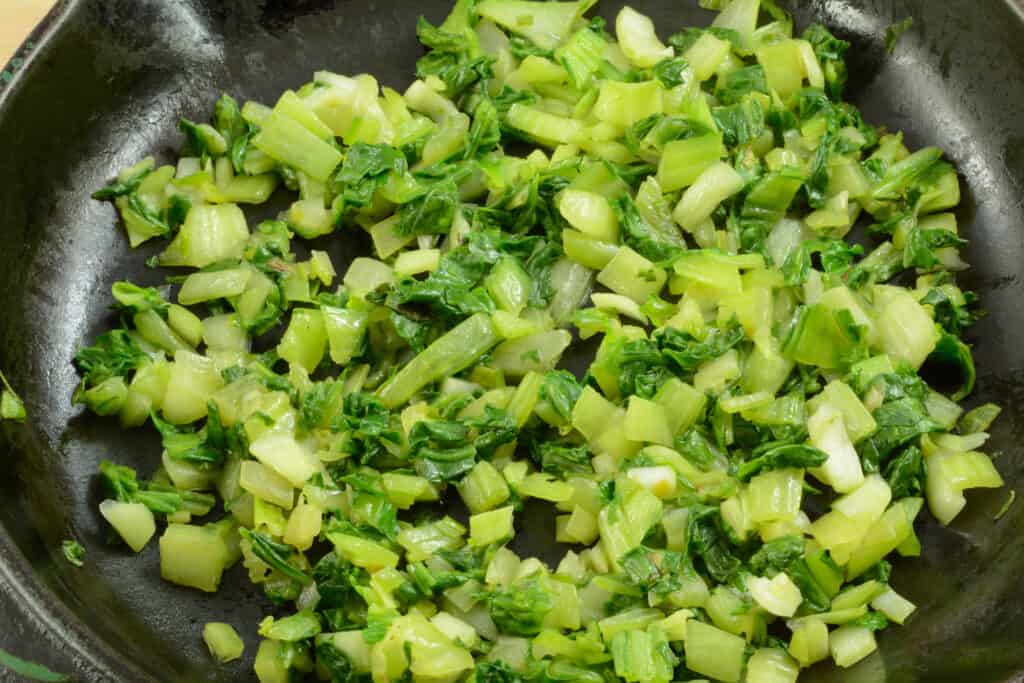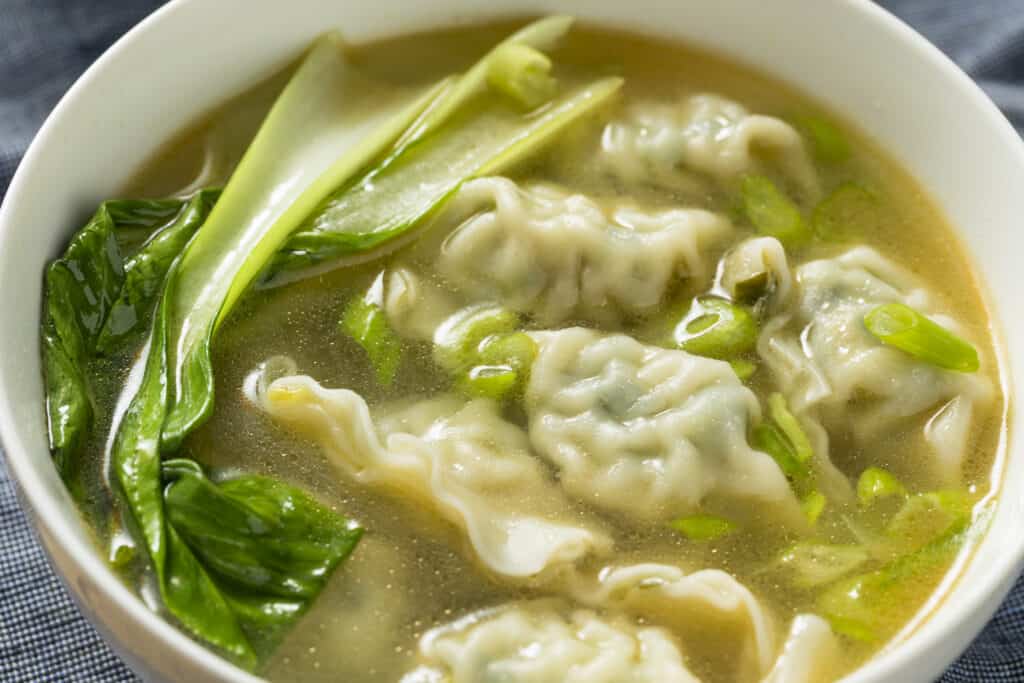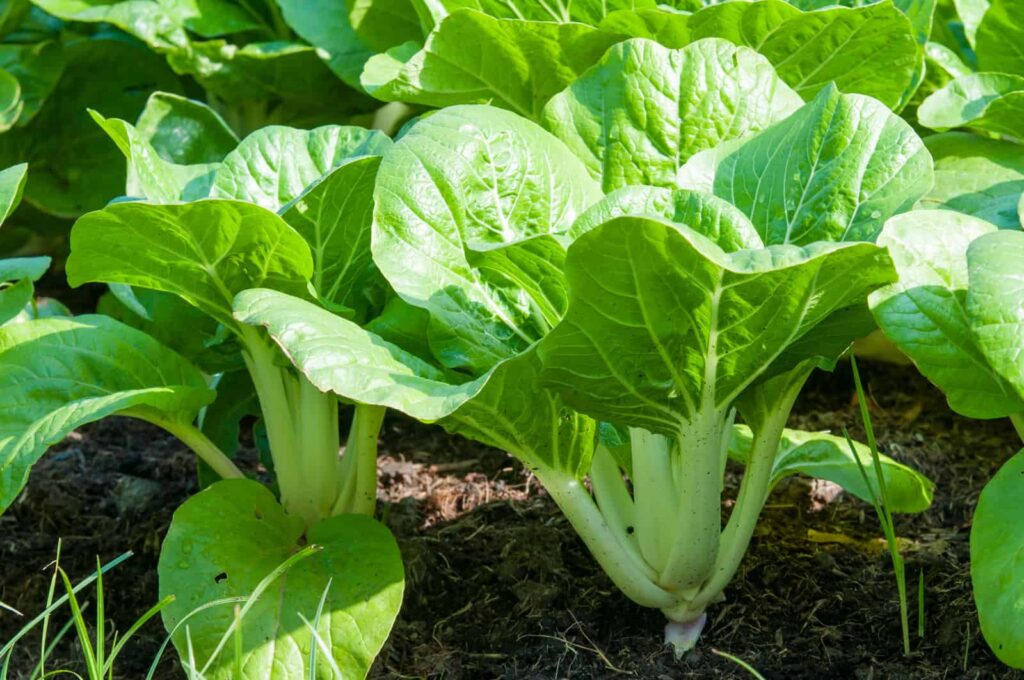Bok choy can be eaten raw in salads, stir-fried, cooked as a vegetable, or marinated. Bok choy has crunchy stalks that are mild and juicy-sweet. Its leaves are tender and crisp with a subtle peppery flavor.
Bok choy is sometimes called Chinese cabbage. The Cantonese variation of bok choy is pak choy.

There are several varieties of bok choy: Canton or dwarf bok choy, Shanghai or green-stemmed bok choy, Taiwan or Fengshan bok choy, and additional variations known as choy sum, tatsoi, and yau choy.
Kitchen Helpers from Amazon:
- Oster Vegetable Steamer
- Chef’s Knives Set of 6
- EZ Off Jar Opener for Weak Hands
- Pepper Core Remover Stainless Steel
- Kitchen Utensils – Set of 35

How to choose bok choy
- Choose bok choy that is compact, firm, and fresh. The ribs should be without brown spots. Avoid leaves that are even slightly wilted.
- Select large-leaved types of bok choy for soup; choose narrower and longer stems for stir-frying.
- To serve bok choy alone or to serve the leaves whole, choose baby bok choy or hearts.
How to store bok choy
- Bok choy will keep 2 or 3 days unwashed in a perforated plastic bag in the refrigerator.
- Bok choy wilts quicker than head cabbage.

How to prepare bok choy
- To prepare mature bok choy, cut the head in half lengthwise or into quarters and wash it thoroughly under the faucet or soak and dunk it in water until the stalks are clean of any dirt or sand from the garden.
- Baby bok choy can be rinsed without cutting it in half.
- Trim the base and discard blemished leaves.
- Separate the stalks as you would celery.
- Shred the leaves from the stalks. Tear the leaves into bite-size pieces.
- Cut the stalks lengthwise and then crosswise, again into bite-sized pieces.
- Wash the leaves and stalks separately before cooking.
Bok choy cooking suggestions
- Cook bok choy stems and leaves will separately.
- Simmer the stalks for about 5 minutes.
- Boil the stalks in salted water for a minute or two and then drain.
- Steam or stir-fry or steam the leaves. The leaves will cook almost instantly.
- For the most delicate flavor, cook bok choy until just cooked and not a moment longer.
- Bok choy cooked right will have a light, refreshing taste. Expect overcooked bok choy to be mushy and dull tasting.
How to steam bok choy
- Add a few inches of water to a pot then insert a steamer basket. The water should not touch the bottom of the steamer basket.
- Bring the water to a simmer over medium-high heat.
- Add whole or shredded leaves and cover.
- Steam until tender, about 4 or 5 minutes.
How to sauté bok choy
- Place a tablespoon of oil in a large skillet and place over medium-high heat.
- Add thinly sliced, shredded, or small whole bok choy leaves and season with soy sauce or salt and pepper.
- Cook, stirring often, until the leaves are tender, about 10 minutes.

How to stir-fry bok choy
- Tear or shred bok choy leaves.
- Heat 2 tablespoons of vegetable oil in a wok.
- Add the leaves and 2 sliced garlic cloves.
- Stir-fry until the leaves start to wilt then add a quarter cup or slightly more vegetable stock.
- Cover and cook for 3 minutes or until just tender.
How to boil bok choy
- Shred or cut bok choy in halves or quarters.
- Bring a lightly salted pot of water to a boil.
- Put bok choy in the pot and boil for about 3 to 5 minutes for shredded leaves, and about 10 minutes for halves and quarters.
- Remove the bok choy with a slotted spoon and dry on a kitchen towel or a paper towel-lined plate.
How to braise bok choy
- Shred or coarsely cut a medium head of bok choy.
- Coat a large skillet with unsalted butter, olive oil, or peanut oil.
- Add the bok choy and stir over medium heat until the leaves wilt and turn light brown around the edges.
- Add salt and pepper lightly or soy sauce, and 1 cup of vegetable stock.
- Cover the skillet tightly and simmer until the bok choy is just tender about 15 to 20 minutes.

Bok choy serving suggestions
- Bok choy can be eaten raw cooked or marinated. Use the stalks and leaves separately.
- The stalks can replace celery and the leaves can be used in place of spinach or chard.
- Use bok choy in a stir-fry mixed with other Asian vegetables. Cook the stalks first. The leaves of bok choy are mostly water so it’s best to cook the leaves separate from the stems. Add the leaves at the last minute since they require very short cooking. The stalks need to cook only a few minutes in order to keep them crisp.
- Cook the stalks to a crisp-tender texture. Stalks will quickly sear with seafood, pork, duck, chicken, beef, and lamb.
- You can add chopped stalks to cooked rice and toss until hot for fried rice.
- To use bok choy in soups, combine stock, meat shreds, ribbons of bok choy leaves and a pinch of ginger then simmer for 5 minutes.
- Baby bok choy is often served whole and has a very delicate flavor.
- In Japan, China, and Korea, bok choy is salted and spiced, and pickled. Pickled bok choy can be sweet, fresh, and lightly vinegary or peppery-hot and long-fermented.
Bok choy nutrition
- Bok choy is a good source of potassium and vitamin A, B, and C and folic acid, calcium, and iron.

Get to know bok choy
- Bok choy can grow from 10 to 20 inches (25-50 cm) tall.
- Young bok choy—which is called “baby” bok choy—is harvested when 4 to 5 inches (10-12 cm) in length.
- The stalks of bok choy are smooth and rounded and bear a resemblance to Swiss chard or celery without the grooves and strings. The leaves are large and spoon-shaped like the leaves of chard or spinach.
- The stalks or ribs of bok choy are whitish, fleshy, crisp, and mild flavored. Some bok choy varieties are short-ribbed and others have long ribs. Because of the stalks similarity to celery, bok choy is sometimes called celery cabbage.
- The leaves of bok choy are green and veined. Bok choy leaves are milder than mustard greens but more biting than Napa cabbage or Chinese leaves.
- Bok choy is a member of the Asian vegetable family that often goes by the generic name Chinese cabbage. But the flavor of bok choy is much more subtle than round-headed cabbage.
- Bok choy originated in China. “Choy” or “choi” is the Romanized word for the Chinese character that means “vegetable.” “Bok” or “pak” means white. Sometimes the word “sum” is added, which means “heart.”
- Bok choy was introduced to the West in the nineteenth century.
- There are dozens of varieties of bok choy.
- The bok choy most commonly found in markets is Canton or dwarf bok choy. It is short and squat with plump, pearly-white stalks that are tender, very juicy, and bland tasting. Dwarf bok choy’s leaves are dark green, somewhat curled, looking a bit like the leaves of chard. They have a cabbagey flavor.
- “Baby” bok choy is used to describe both the dwarf Canton bok choy and other bok choys picked small and immature.
The botanical name for bok choy is Brassica var. chinensis.
Related articles:
How to Plant, Grow, and Harvest Chinese Cabbage
Five Ways to Cook and Serve Chinese Cabbage
Four Ways to Cook and Serve Napa Cabbage
Five Ways to Cook and Serve Bok Choy
How to Plant, Plant, Grow, and Harvest Mizuna
Ways to Prepare and Serve Mizuna
How to Cook and Serve Bitter Melon
Also of interest:
Articles of interest:
Best Herbs for Container Growing
Garden Planning Books at Amazon:
- Vegetable Garden Almanac & Planner
- Kitchen Garden Grower’s Guide Vegetable Encyclopedia
- Vegetable Garden Grower’s Guide
- Tomato Grower’s Answer Book
More kitchen tips:
Bring your harvest to the table. Kitchen prep tips and easy recipes for the vegetables you grow. Click below for vegetable prep and recipes you can use now.
- Almonds
- Apples
- Apricot
- Aprium
- Artichoke
- Arugula
- Asparagus
- Avocado
- Bamboo Shoots
- Banana
- Basil
- Beans, Dried
- Beans. Long
- Beans, Shell
- Beans, Snap
- Beets
- Bitter Melon
- Blackberry
- Bok Choy
- Broccoli
- Broccoli Raab
- Brussels Sprouts
- Cabbage
- Cardoon
- Carrots
- Cauliflower
- Celeriac
- Celery
- Chard
- Chayote Squash
- Cherimoya
- Cherries
- Chestnut
- Chickpea
- Chinese Cabbage
- Chives
- Cilantro
- Citron
- Clementine
- Collards
- Coriander
- Corn, Sweet
- Corn, Baby
- Corn Salad, Mache
- Cranberry
- Cress
- Cucumber
- Daikon
- Dandelion
- Dill
- Eggplant
- Endive, Belgian
- Endive and Escarole
- Fava Beans
- Fig
- Florence Fennel
- Garlic
- Ginger
- Grapefruit
- Grapes
- Guava
- Horseradish
- Jerusalem Artichoke
- Jicama
- Jujube
- Kale
- Kiwifruit
- Kohlrabi
- Kumquat
- Leeks
- Lemongrass
- Lemons
- Lettuce
- Lime
- Mache (Corn Salad)
- Mandarin Orange
- Mango
- Maple Syrup
- Marjoram
- Melons
- Michihili
- Mint
- Mizuna
- Mushrooms
- Mushrooms, Cremini
- Mustard Greens
- Napa Cabbage
- Nectarine
- Okra
- Olives
- Olive oil
- Onions
- Oranges
- Oregano
- Parsley
- Parsley Root
- Parsnips
- Passion Fruit
- Pawpaw
- Peaches
- Pears
- Peas, Garden Snap
- Peas, Snow
- Pei Tsai
- Peppers, Chili
- Peppers, Sweet
- Persimmon
- Pineapple
- Pineapple Guava
- Plantain
- Plums
- Pluots
- Pomegranate
- Potatoes
- Prickly Pear
- Pumpkin
- Quince
- Radicchio
- Radishes
- Raspberries
- Rosemary
- Rhubarb
- Rutabaga
- Sage
- Salsify
- Sauerkraut
- Savory
- Shallots
- Sorrel
- Spinach
- Squash, Summer
- Squash, Winter
- Strawberries
- Sunchokes
- Sunflower
- Sweet Potato
- Swiss Chard
- Tangerine
- Taro
- Tarragon
- Thyme
- Tomatillo
- Tomato
- Turnip
- Turnip Greens
- Yams















